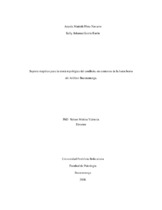Mostrar el registro sencillo del ítem
Soporte empírico para la Teoría topológica del conflicto en contextos de la barra brava del atlético Bucaramanga
| dc.contributor.advisor | Molina Valencia, Nelson | |
| dc.contributor.author | García Baron, Kelly Johanna | |
| dc.contributor.author | Pérez Navarro, Anyela Marieth | |
| dc.coverage.spatial | Seccional Bucaramanga. Universidad Pontificia Bolivariana. Escuela de Ciencias Sociales. Facultad de Psiocología | spa |
| dc.coverage.temporal | 2008 | |
| dc.date.accessioned | 2013-06-17T19:38:08Z | |
| dc.date.available | 2013-06-17T19:38:08Z | |
| dc.date.created | 2008-04-17 | |
| dc.date.issued | 2013-06-17 | |
| dc.identifier.uri | http://hdl.handle.net/20.500.11912/125 | |
| dc.description | 153p.: (pdf); il; tablas; anexos | spa |
| dc.description.abstract | Los conflictos surgen a partir de la identificación de objetos que son comunes a dos o más actores. Una manera de conocer los conflictos, propuesta teóricamente desde la topología de los mismos, en donde se deja de lado la solución para proponer la transformación de las relaciones, los espacios y las intrepretaciones (Molina, 2004), que mediante estrategias vinculan nuevos métodos de intervenciones que fortalecen el ejercicio de cada uno de los actores. Para este caso, se estudió el conflicto existente en los contextos en que interactúa la barra brava de Bucaramanga desde una mirada etnográfica,(investigación cualitativa)que explica las evidencias empíricas que sustentan la teoría topológica del conflicto, objetivo principal de la presente investigación. La población abordada durante la investigación fueron: ESMAD, Espectadores y jugadores del atlético Bucaramanga y barra brava de Bucaramanga (F.L.S), siendo estos últimos el eje central de la investigación. Por cada población se tomó una muestra de cuatro actores, 16 personas en total de las cuales se utilizaron los siguientes instrumentos: un protocolo de entrevista semiestructurada, observación participante,resgistros de campo y se realizó el análisis por medio del programa Atlas ti. En los resultados se encontraron evidencias empíricas que sustentan la teoría topológica del conflicto. De la categorización de las entrevistas, se identificaron cuatro elementos de análisis que responden a su vez a los cuatro objetivos específicos planteados en la tesis; los objetivos de conflicto que se genera en el contexto de los jugadores y la barra brava,la identificación de los factores que desencadenan los conflictos con los actores en disputa y la comprensión de las situaciones conflictivas que se evidenciaron a lo largo del trabajo en los contextos de la barra brava de Bucaramanga. | spa |
| dc.description.abstract | The conflicts arise from the identification of objects that are common to two or more actor. A way of recognizing the conlicts, proposed theoretically from the topología of the same ones, where the solution is left of side to propose the transformation of the relations, the spaces and the interpretations (Molina, 2004), that by means of strategies link new methods of interventions that strengthen the exercise (fiscal year) of each one of the actors. For this case, the existing conflict was studied in the contexts in which the brave bar of the Bucaramanga interacts from an ethnographic look, (Qualitative Investigation) that explains the empirical evidences that sustain the tehory topologica of the conflict, principal aim of the present investigation. The population approached during the investigation they were: ESMAD, Spectators and Players of the Athletic Bucaramanga and Brave Bar of the Bucaramanga (F.L.S), being the above mentioned the backbone of the investigation. The population approached during the investigation (research) they were: ESMAD, Spectators and Players of the Athletic Bucaramanga and Brave Bar of the Bucaramanga (F.L.S), being the above mentioned the backbone of the investigtion. For every population there took a sample of four actors, 16 persons in whole whit chich the following instruments were in use: a protocol of semiconstructed interview, obserbation participant, field records and I realize the analysis by means of the program Atlas You. In the results they found emperical evidences that sustian the theory toplogica of the conflict. Of the categorization of the interviews, there were identified four elements of analyses that answer in turn to four specific aims raised in the thesis; The objects of conflict that vehiculan the relation ESMAD - Brave Bar; and Players -Brave Bar, the temporality of the conflict that is generated in the context of the players and the brave bar, the identification of the factors that unleash the conflicts with te actors in dispute and, the comprehension of the troubled situations that were demonstrated along the work in the contexts of the brave bar of the Bucaramanga. | |
| dc.language.iso | es | |
| dc.rights | Attribution-NonCommercial-NoDerivatives 4.0 International | * |
| dc.rights.uri | http://creativecommons.org/licenses/by-nc-nd/4.0/ | * |
| dc.subject | Psicología | spa |
| dc.subject | Tesis y disertaciones académicas | spa |
| dc.subject | Psicología deportiva | spa |
| dc.subject | Deportes - aspectos psicológicos | spa |
| dc.subject | Medicina deportiva | spa |
| dc.subject | Psicología social | spa |
| dc.subject | Trabajos de grado psicología | spa |
| dc.title | Soporte empírico para la Teoría topológica del conflicto en contextos de la barra brava del atlético Bucaramanga | spa |
| dc.type | bacherlorThesis | spa |
| dc.rights.accessRights | openAccess | spa |
| dc.type.hasVersion | publishedVersion | spa |
| dc.identifier.instname | instname:Universidad Pontificia Bolivariana | spa |
| dc.identifier.reponame | reponame:Repositorio Institucional de la Universidad Pontificia Bolivariana | spa |
| dc.identifier.repourl | repourl:https://repository.unab.edu.co/ |
Ficheros en el ítem
Este ítem aparece en la(s) siguiente(s) colección(ones)
-
Trabajos de grado [6440]
Monografías, artículos, informes, proyecto de grado


